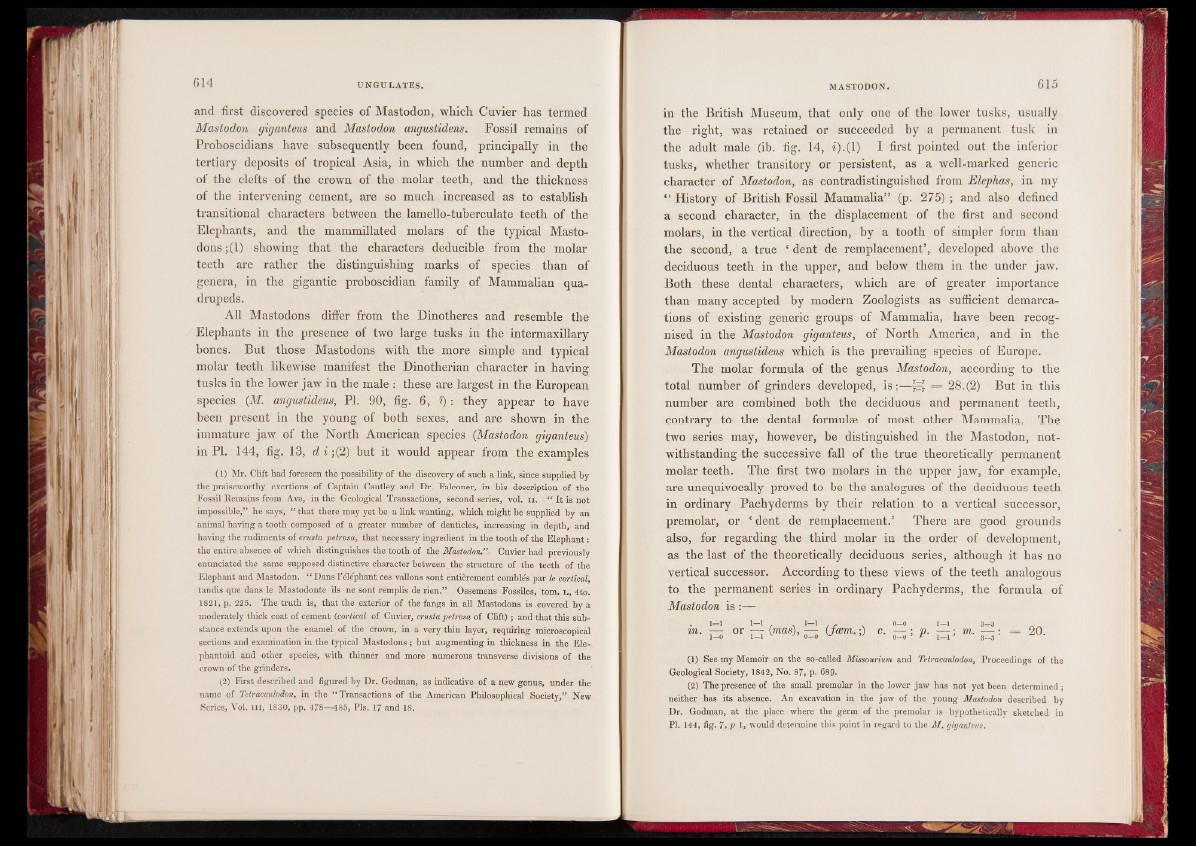
and first discovered species of Mastodon, which Cuvier has termed
Mastodon giganteus and Mastodon angustidens. Fossil remains of
Proboscidians have subsequently been found, principally in the
tertiary deposits of tropical Asia, in which the number and depth
of the clefts of the crown of the molar teeth, and the thickness
of the intervening cement, are so much increased as to establish
transitional characters between the lamello-tuberculate teeth of the
Elephants, and the mammillated molars of the typical Mastodons
;(1) showing that the characters deducible from the molar
teeth are rather the distinguishing marks of species than of
genera, in the gigantic proboscidian family of Mammalian quadrupeds.
All Mastodons differ from the Dinotheres and resemble the
Elephants in the presence of two large tusks in the intermaxillary
bones. But those Mastodons with the more simple and typical
molar teeth likewise manifest the Dinotherian character in having
tusks in the lower jaw in the male : these are largest in the European
species (M. angustidens, PI. 90, fig. 6, *) : they appear to have
been present in the young of both sexes, and are shown in the
immature jaw of the North American species (Mastodon giganteus)
in PI. 144, fig. 13, d i ;(2) but it would appear from the examples
(1) Mr. Clift had foreseen the possibility of the discovery of such a link, since supplied by
the praiseworthy exertions of Captain Cautley and Dr. Falconer, in his description of the
Fossil Remains from Ava, in the Geological Transactions, second series, vol. ii. “ It is not
impossible,” he says, “ that there may yet he a link wanting, which might he supplied by an
animal having a tooth composed of a greater number of denticles, increasing in depth,- and
having the rudiments of crusta petrosa, that necessary ingredient in the tooth of the Elephant :
the entire absence of which distinguishes the tooth of the Mastodon.”. Cuvier had previously
enunciated the same supposed distinctive character between the structure of the teeth of the
Elephant and Mastodon. “ Dans l’éléphant ces vallons sont entièrement comblés par le cortical,
tandis que dans le Mastodonte ils ne sont remplis de rien.” Ossemens Fossiles, tom. i., 4to.
1821, p. 225. The truth is, that the exterior of the fangs in all Mastodons is covered by a
moderately thick coat of cement (cortical of Cuvier, crusta petrosa of Clift) ; and that this substance
extends upon the enamel of the crown, in a very thin layer, requiring microscopical
sections and examination in the typical Mastodons ; but augmenting in thickness in the Ele-
phantoid and other species, with thinner and more numerous transverse divisions of the
crown of the grinders.
(2) First described and figured by Dr. Godman, as indicative of a new genus, under the
name of Tetracaulodon, in the “ Transactions of the American Philosophical Society,” New
Series, Vol. in, 1830, pp. 478—485, Pis. 17 and 18.
in the British Museum, that only one of the lower tusks, usually
the right, was retained or succeeded by a permanent tusk in
the adult male (ib. fig. 14, i).(l) I first pointed out the inferior
tusks, whether transitory or persistent, as a well-marked generic
character of Mastodon, as contradistinguished from Elephas, in my
“ History of British Fossil Mammalia” (p. 275) ; and also defined
a second character, in the displacement of the first and second
molars, in the vertical direction, by a tooth of simpler form than
the second, a true ‘ dent de remplacement’, developed above the
deciduous teeth in the upper, and below them in the under jaw.
Both these dental characters, which are of greater importance
than many accepted by modern Zoologists as sufficient demarcations
of existing generic groups of Mammalia, have been recognised
in the Mastodon giganteus, of North America, and in the
Mastodon angustidens which is the prevailing species of Europe.
The molar formula of the genus Mastodon, according to the
total number of grinders developed, is:—£5? = 28.(2) But in this
number are combined both the deciduous and permanent teeth,
contrary to the dental formulae of most other Mammalia. The
two series may, however, be distinguished in the Mastodon, notwithstanding
the successive fall of the true theoretically permanent
molar teeth. The first two molars in the upper jaw, for example,
are unequivocally proved to be the analogues of the deciduous teeth
in ordinary Pachyderms by their relation to a vertical successor,
premolar, or jj dent de remplacement.’ There are good grounds
also, for regarding the third molar in the order of development,
as the last of the theoretically deciduous series, although it has no
vertical successor. According to these views of the teeth analogous
to the permanent series in ordinary Pachyderms, the formula of
Mastodon is
in- ' l l or 1=1 (mas)> S C/®»»-;) c- P’ m- S : % 20-
(1) See my Memoir on the so-called Missourium and Tetracaulodon, Proceedings of the
Geological Society, 1842, No. 87, p. 689.
(2) The presence of the small premolar in the lower jaw has not yet been determined;
neither has its absence. An excavation in the jaw of the young Mastodon described by
Dr. Godman, at the place where the germ of the premolar is hypothetically sketched in
PI. 144, fig. 7, p 1, would determine this point in regard to the M. giganteus.